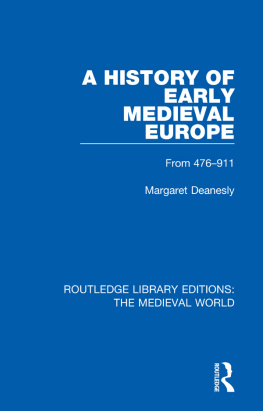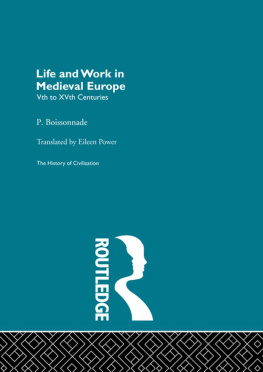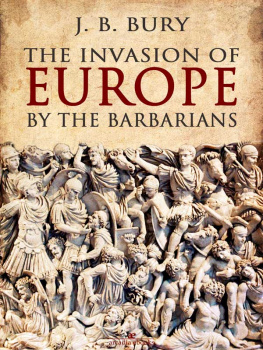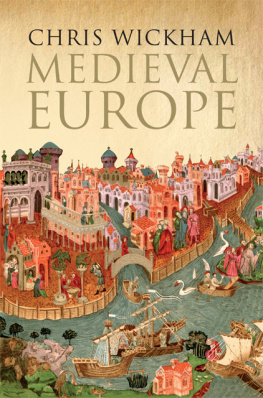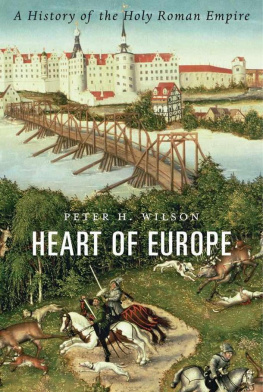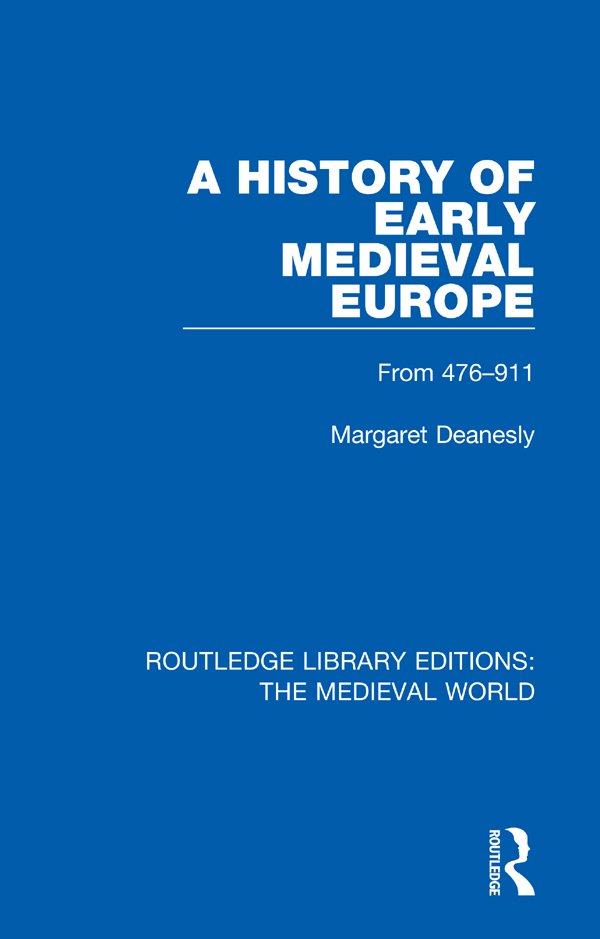
ROUTLEDGE LIBRARY EDITIONS: THE MEDIEVAL WORLD
Volume 10
A HISTORY OF EARLY MEDIEVAL EUROPE
A HISTORY OF EARLY MEDIEVAL EUROPE
From 476911
MARGARET DEANESLY

First published in 1956
This edition reprinted in 1974 by Methuen & Co Ltd
This edition first published in 2020
by Routledge
2 Park Square, Milton Park, Abingdon, Oxon OX14 4RN
and by Routledge
52 Vanderbilt Avenue, New York, NY 10017
Routledge is an imprint of the Taylor & Francis Group, an informa business
1956 Margaret Deanesley
All rights reserved. No part of this book may be reprinted or reproduced or utilised in any form or by any electronic, mechanical, or other means, now known or hereafter invented, including photocopying and recording, or in any information storage or retrieval system, without permission in writing from the publishers.
Trademark notice: Product or corporate names may be trademarks or registered trademarks, and are used only for identification and explanation without intent to infringe.
British Library Cataloguing in Publication Data
A catalogue record for this book is available from the British Library
ISBN: 978-0-367-22090-7 (Set)
ISBN: 978-0-429-27322-3 (Set) (ebk)
ISBN: 978-0-367-18438-4 (Volume 10) (hbk)
ISBN: 978-0-429-06153-0 (Volume 10) (ebk)
Publishers Note
The publisher has gone to great lengths to ensure the quality of this reprint but points out that some imperfections in the original copies may be apparent.
Disclaimer
The publisher has made every effort to trace copyright holders and would welcome correspondence from those they have been unable to trace.
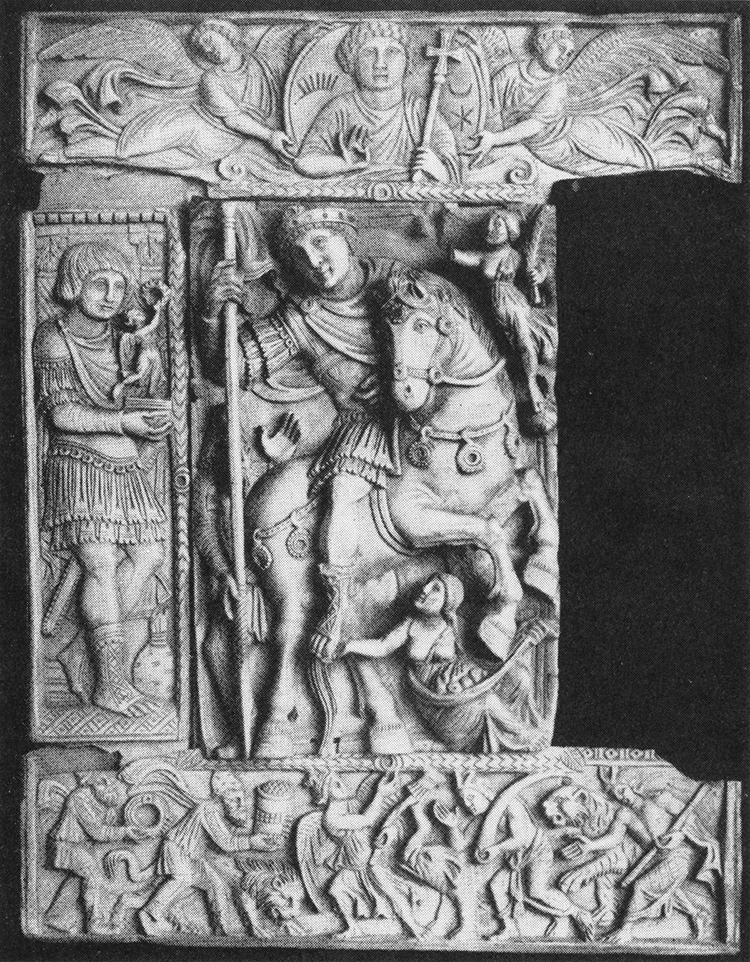
TRIUMPH OF A BYZANTINE EMPEROR (p. 146)
Barberini ivory: Early 6th century
A History of Early Medieval Europe
FROM 476 TO 911

Margaret Deanesly
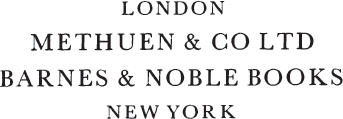
First published 1956
This edition reprinted 1974 by
Methuen & Co Ltd
11 New Fetter Lane
London EC4P4EE
and Barnes & Noble Books (New York)
10 East 53rd Street
New York NY 10022
(a division of Harper & Row Publishers Inc.)
Printed in Great Britain by
Whitstable Litho, Straker Brothers Ltd
Methuen SBN 416 79030 X
Barnes & Noble SBN 06 4714837
PREFACE
I N dealing with so large a subject as the history of early medieval Europe, and in a relatively small volume, the temptation to give most space to what most interests oneself is very strong. I can only say in apology that I share my interests with the present generation of history students: or that they have, more probably, inspired them in me. I have tried, in fact, while dealing with the political backbone, the succession of events, in early medieval Europe, to indicate also the ancestry of her culture and institutions. This is, indeed, not quite a simple matter, for though undoubtedly our richest inheritance comes from our Greco-Roman and Germanic forbears, we had culturally a lot of incidental ancestors as well. It was the nomads settled in the Crimea who taught us to use safetypins, and the Syrian merchants to eat black [French] plums at Christmas.
With regard to the brief chronological treatment of the history of the different European countries, I have probably overloaded the story with proper names, but this is intended to guide students using the chroniclers and the larger monographs. I have used the forms of proper names given in the Cambridge Medieval History, while preferring (if there is a difference) those of The Shorter Cambridge Medieval History. I have used the modern forms of placenames (if such exist), and, where possible, those of The Oxford Atlas, O.U.P., 1951.
As customary in this series, the history of Britain is omitted, except for casual references in allusion or for comparison.
The bibliographical notes again are highly selective. It is to be hoped that in addition to the maps provided, recourse will be had to R. L. Pooles Historical Atlas of Modern Europe, the maps in the Cambridge Medieval History, or Muirs Historical Atlas: medieval and modern, ed. G. Goodall and R. F. Treharne, 8th ed. 1952.
To those who have kindly helped me I owe great thanks, in particular to Professor Joan Hussey for Byzantine illumination in general and for reading and correcting the Byzantine chapters. For me, Professor Hussey lit the Byzantine candles. I owe similar thanks to Professor R. R. Betts with regard to the Slavs and for reading chapter xxv: to Professor B. Lewis with regard to Islam and reading chapter xi: and to Dr Florence Harmer with regard to the Scandinavians and for reading the relevant part of chapter xxiv. I am most grateful also to Professors M. Cary and F. Wormald, for help over a number of years.
MARGARET DEANESLY
196 CLARENCE GATE GARDENS
LONDON, N.W.I
PREFACE TO THE SECOND EDITION
I SHOULD like to thank the reviewers of the first edition of this book, and those who wrote letters about it, for pointing out slips and errors and making many suggestions. The errors I hope I have corrected in this edition. The suggestions I have tried to use, short of rewriting large portions of the book or much increasing its length.
The suggestion that the first edition of the book has a strong west-European bias I have tried to deal with, short of serious alteration of spacing. In this matter I have to thank Mr W. Jardine Grisbrooke, whose learning and attractions are east European rather than west European, for much help; I also owe him many thanks for general help in proof reading.
MARGARET DEANESLY
196 CLARENCE GATE GARDENS
LONDON, N.W.I
CONTENTS
The barbarians without and within the empire in 476, and what the barbarians found. The Roman heritage: political government: civil administration: the Roman army: towns: trade: the Christian faith
The races of barbarians outside the Roman empire: the Germanic language and culture: the Mongol language and nomad culture: the Goths and their movements to 476: Vandals, Burgundians, Franks and Anglo-Saxons
The Ostrogothic arrival and Cassiodorus history of the Goths: Theoderics conquest and machine of government; Gothic Arianism; Theoderics foreign policy and the dangers from Catholic provincials and the eastern emperor; Theoderics death and the succession difficulties; the Gothic wars and Justinians reconquest of Italy; Gothic art and buildings; the Cassiodoran effort to save Roman learning at Vivarium
The early Franks; Gregory of Tours and his History of the Franks; Cloviss conquests and conversion; defeat of the Visigoths at Vougl; the Frankish rgime under Clovis and his sons, central and local government, society, and the Salic law; the division of the kingdom in 511 between Cloviss four sons, and their wars and further conquests; Frankish bishops, church-buildings, ornaments and art; the monastic life in Gaul and under the early Franks
Next page
